Part I: Animals
Mountains are the “water towers of the world”. More than half of the world’s fresh water comes from mountain runoff and a large percentage of that runoff is glacial meltwater. The mountain headwaters of Glacier National Park (GNP) drain into the Gulf of Mexico, the Pacific Ocean, and Hudson Bay watersheds so it is an important source of water for the North American continent.
Click on the pics to enlarge.
As we all know, global warming is causing rapid decline in glacier mass worldwide. USGS scientists predict the glaciers in GNP will be completely gone by 2030. In 1850, at the end of the Little Ice Age, there were an estimated 150 glaciers in the park. Today there are only 26 and they are greatly reduced in size. Here’s a really neat animated model showing the glacier retreat from 1850-2100 and how that affects the vegetation zones found in the park. The zones move upslope as conditions become warmer and dryer. It’s obvious this will have a big impact on the flora and fauna in these habitats. Longer fire seasons are also predicted. While some fire is good for renewal of ecosystems, too frequent or too intense fires can lead to conditions where invasive species move in and take over from native ones.
GNP has been designated a Mountain Biosphere Reserve by the United Nations (UNESCO) and the USGS Northern Rocky Mountain Science Center (NOROCK) has a highly regarded research program on Climate Change at the Park.
For reasons mentioned above and simply for it’s incredible beauty, Glacier National Park is a precious treasure.
At the time I visited (last week of July) Glacier had lots of water. The 2007-08 winter season had 150-175% of normal snowfall. There were 80 ft. drifts on Logan Pass and the Going-to-the-Sun Road didn’t open until July 2nd this year – the latest date in recent history. Waterfalls cascaded down mountainsides everywhere you looked. The vegetation was lush and green with colorful wildflowers in the meadows. Berries were predicted to be a bumper crop – good news for the bears. Many of the trails were covered in snow too and had just opened before we got there.
We were told it was highly unusual for the trail to Hidden Lake to have any snow on it. Lots of slipping and sliding going on up here.
This is where the trail led – about 1.5 miles from the Logan Pass visitor center. I experimented with the panorama setting on my camera which allows you to combine multiple photos. This is around 5-7 photos stitched together. Click the pic for full size.
There are 131 named lakes in the Park. The water temperature never gets above 50 F so plankton don’t grow and this makes the lakes unusually clear. As glaciers move they grind the bedrock beneath them into a fine powder called glacial flour. These particles become suspended in the lakes and reflect back an amazing tuquoise color. Some examples below.
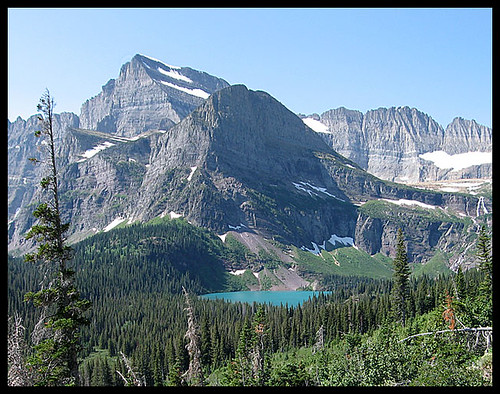
Grinnell Lake and Grinnell Falls (far right) from the Grinnell Glacier Trail
George Bird Grinnel was an early American explorer and naturalist. He was dedicated to wildlife preservation and conservation and was influential in the establishment of Glacier NP in 1910.
Here are some glaciers, finally! The patch in the upper right corner is Salamander Glacier (note it appears in the photo above – on the mountain to the far right). In the middle and tucked in below the shadow of the mountain is Grinnell Glacier. At one time these glaciers were connected. The foreground is actually an ice-covered lake. You see the crystal blue water just starting to melt. It’s name, you might have guessed, Upper Grinnell Lake.
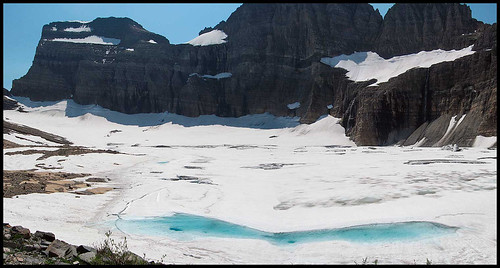
Grinnell & Salamander Glaciers
More Lakes….
and Waterfalls…
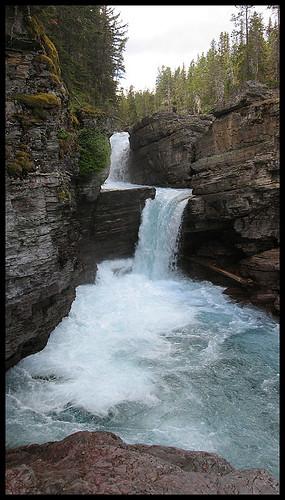
St. Mary Falls (height about 50 ft.)
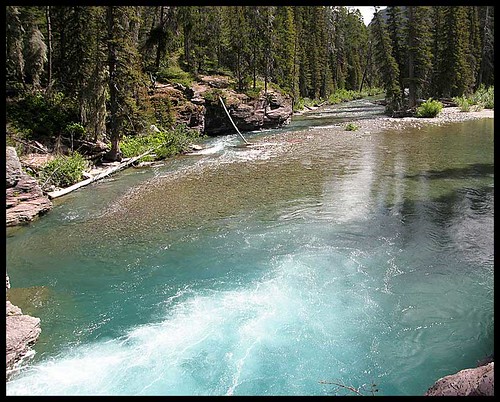
St. Mary River (this is looking the opposite direction from the falls above; showing that nice blue color going downstream)
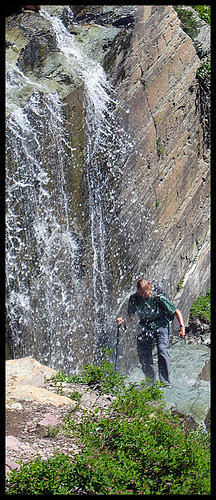
My Sister on Grinnell Glacier Trail
(you didn’t have a choice but to go through it or go back. Icy cold! but refreshing!)
Photos were taken with a Canon PowerShot S80 (point & shoot) and have been edited and Photoshopped to adjust the light, sharpness, and color quality. Click the images for a larger version. In the interest of preserving the large format images I didn’t optimize the file sizes (except for the pic above the fold). Apologies to our dialup users for that.
Unless otherwise cited, info is from the National Park Service’s brochure titled Climate Change (undated) .

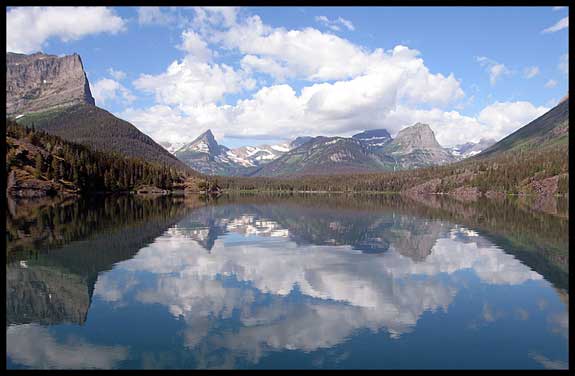
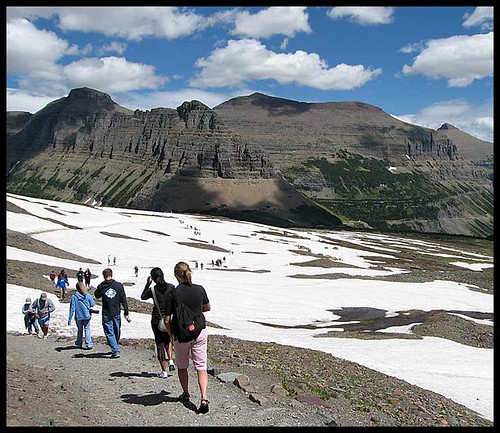




53 comments
Skip to comment form
Author
and one more pic…
On the Red Bus
For a nominal fee these vintage motor coaches take 17 passengers on full- or half-day tours over the Going to the Sun Road and other sites in the park. The canvas tops are rolled back for open air views. I didn’t get to do this but I definitely think these buses are snazzy. They run on clean burning LPG (propane) so they are eco-friendly too.
that some people have to imagine a heaven in the sky, when all they have to do is look at places like these?
Beautiful, OTB!
Part one of the San Diego Zoo will go up sometime tomorrow.
I wish I had your skill.
but it made me think of this song.
Just the mood mountains have, I guess…
fantastic jigsaw puzzles. So beautiful and serene. 🙂
but most of those pictures are SO beautiful that they almost don’t look real. but this is clearly an example of heaven on earth. stunning diary. information excellent too.
I tried to explain that point about the watershed in a Kos diary. If you think about it, I would bet 75% if not more of the west’s water comes from the mountains, which is almost all federal (our) land.
It’s hard to find the words to describe my feelings. Your pictures display both a tender gentleness and massive magnificence. And then there is always the humor, here your sis getting the icy shower. Makes me remember the seals at the Olympic Torch relay.
I really like your work, and thank you for your beautiful spirit.
These photo diaries are like a mini vacation for me. Thank you so much.
I wish I could see sights like these with my own eyes, but this is the next best, you know?
You have an eye, indeed.
I was amazed at how Hidden Lake Trail is actually swarming with people. I’d have never guessed that. I hope to hell they only leave footprints, and barely those.
Thank you so much for taking us with you, dear. You are a generous soul.
The content of these photos had me sitting here with my mouth gaping — in awe of all the magnificence. How wonderful it is that you were THERE to see it in person. Outstanding photos, OTB!
Thanks for the narrative information, as well — so well put together.
Thank you for letting us “tag along” with you on this wonderful experience!
Waaaaaaaaaaaaaaaaaaaaaaah!
A very beautiful photo essay. Thank you for taking the time & the shots which took me along on your journey. And what a great trip it`s been.
90% of my shots are with a small “point & shoot”, & I`m proud of all 120,000 of them.
I can still feel the chill of the icy water, tempered by the beauty of your shots.
Thanks OTB